
Shore Birds
Shore birds live near waterbodies throughout Oregon from the coast to the desert.

Types of Shore Birds
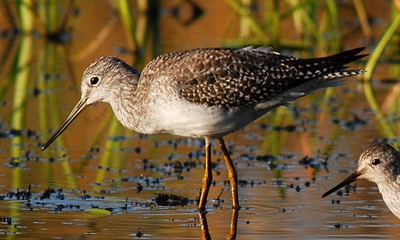
This tall, pale wader is often first detected by its ringing calls as a small flock maneuvers to land in shallow water along an estuary or lakeshore.
The long, often slightly upturned bill and very long yellow legs make this one of the easier shorebirds to identify despite its subdued, speckled gray and white plumage.
It is an uncommon to locally common migrant on shorelines and open wet areas statewide. It winters on the coast and locally inland. In addition to using shallow water in estuaries and along lake margins, these birds can often be found in flooded pastureland, especially in winter, when they seem to prefer this habitat to the more typical estuarine areas.
Hear the call of the Greater yellowlegs
Phogo by Dave Budeau, ODFW
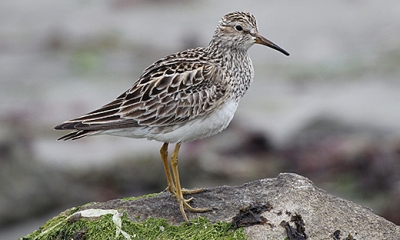
These brownish, heavily streaked, medium-sized shorebirds are often seen peering over grass in the more overgrown parts of mudflats, especially in fall.
It is found statewide in migration; largest numbers in fall, and it is sometimes all but absent in spring. It is common on the outer coast but also in wet coastal pastures. They are more local inland but large flocks can be found in preferred habitat.
Hear the call of the Pectoral sandpiper
Photo by Jason Crotty, Flickr

At first look, the Willet is a rather drab and nondescript medium-sized shorebird found in wetland habitats and nearby uplands. However, further observation reveals subtle patterning in its relatively uniform grayish plumage and birds in flight expose a distinct, bold white wing bar that contrasts with a black border. Sexes are similar in appearance at all times of the year.
Willet are present on breeding grounds in Oregon for a short period of time during spring and summer, but displaying birds are conspicuous and emit a loud and persistent "pill-will-willet" call. These vigilant and vocal individuals often hover overhead and alight on fence posts or the tips of bushes near nesting territories. They are a common spring and summer resident east of the Cascades in Klamath, Lake, Harney, Malheur, and Grant counties.
Photo by Dave Budeau, ODFW

This is a portly, brightly colored shorebird, typically found in coastal salt marshes, mud flats, and sandy margins of freshwater ponds.
Migrant juveniles rather than adults appear in Oregon. They have a flattish, dark rufous-colored crown with fine black streaking. The crown gives the appearance of a jaunty "cap" sitting forward on the head and abruptly ending at the rear. The breast is rich orange-buff shading into the white lower breast and belly. The well-defined creamy-white supercilium broadens behind the eye and is visible at a considerable distance. This is one of the most distinctive field marks on juveniles.
They are an irregular transient in fall on the Oregon coast. They are occasional in the Willamette Valley and in eastern Oregon.
Photo from Birdsaspoetry, Flickr

This small, remarkably delicate long-legged wader can be found in migration across most of Oregon.
It is speckled gray and white with some variation by season and is typically noticed mincing about in shallow pools and in the water adjacent to mudflats or on seasonally flooded fields, as well as in small isolated ponds.
It is an uncommon to common migrant, most birds in fall. In the eastern one-third of Oregon, it usually outnumbers Greater yellowlegs in fall.
Hear the call of the Lesser yellowlegs
Photo by Dave Budeau, ODFW
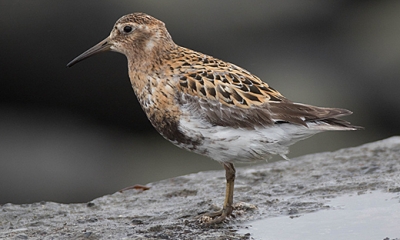
This medium sized, stocky sandpiper is rarely observed away from the rocky coastline as it forages close to the zone of salt spray. Primarily a late fall migrant with the major influx into Oregon occurring the last week in October and into early November.
Generally silent during migration and on wintering grounds. Often found singly or in small groups with foraging Black turnstones and Surfbirds. Cryptic plumage makes it difficult to observe as it forages slowly over mussel and barnacle beds in typical sandpiper fashion. Roosts on rocks with Black turnstones and Surfbirds near feeding grounds, just above the spray zone.
Hear the call of the Rock sandpiper
Photo from Bugora, Flickr

One of Oregon's rarest breeders, this distinctive "shorebird" is known for its courtship display flight and loud curlew-like call. it often perches in pine trees or on fence posts adjacent to nesting areas.
A small plover-like head and short, strait bill seem out of proportion to its body, which is reminiscent of a small curlew.
The Upland sandpiper is a rare breeder in large montane meadows within forests of eastern Oregon. They are almost never observed away form the breeding grounds in Oregon.
The Upland sandpiper is an Oregon Conservation Strategy Species in the Blue Mountains ecoregion.
Hear the call of the Upland sandpiper
Photo from US Fish and Wildlife Service
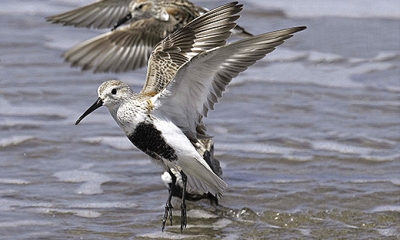
The Dunlin undergoes one of the most dramatic changes in appearance of all shorebirds when it molts from winter to breeding plumage. In winter, these medium sized sandpipers are brownish gray above with white underparts, but in breeding plumage they have a striking rufous-brown back and cap and black belly. Females are larger than males but otherwise similar in appearance.
The Dunlin is an abundant transient and winter visitant in estuaries and occasionally on beaches along the coast of Oregon, but significant numbers winter in the Willamette Valley, especially the southern part.
Photo by Tim Moore
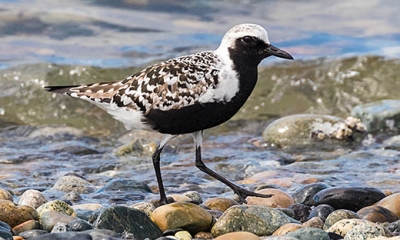
Western Oregon observers enjoy these large, elegant plovers almost year-round, and as a consequence they are one of the most familiar larger shorebirds.
Almost all migrants and winterers visiting Oregon inhabit mudflats and open wet dirt fields. A few can be found on sand beaches and even occasionally on rocks, but the great majority are found feeding and resting on open mud.
In Oregon, it is a fairly common to common transient in western interior valleys. East of the Cascades, the Black-bellied plover is an uncommon transient in the Klamath Basin and at Malheur National Wildlife Refuge. In winter it is a common resident on the coast.
Hear the call of the Black-bellied plover
Photo by Mark Peck, Flickr

This large brown shorebird is the most wide-ranging of the curlew species.
It is distinctive, having contrasting light-brown and dark-brown head stripes and a long decurved bill that it uses to probe for food on coastal mud flats and beaches.
It is a common spring and fall migrant in coastal areas although it is also found, rarely, in small numbers inland as well. It is a rare spring migrant in the Willamette Valley with generally about one record annually, typically in late April or early May.
Photo by ©Keith Kohl, ODFW
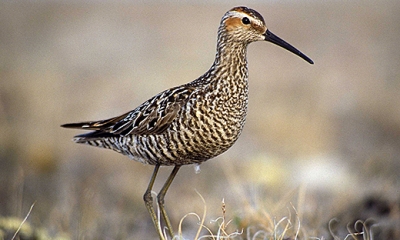
This slender sandpiper is a rare but nearly annual visitor to Oregon. Although easily overlooked, its drooped bill, light eyeline, long neck, long greenish legs, and unstriped wings in flight help set this medium-sized shorebird apart from similar species.
Its preferred habitat during migration is shallow freshwater, usually avoiding mudflats and beaches. It feeds on invertebrates such as midge, beetle and mosquito larvae.
A rare fall and occasional spring transient, it is most frequently found in estuarine habitat along the coast. It is also found along the shorelines of the Great Basin region.
Hear the call of the Stilt sandpiper
Photo by Mark Peck, Flickr
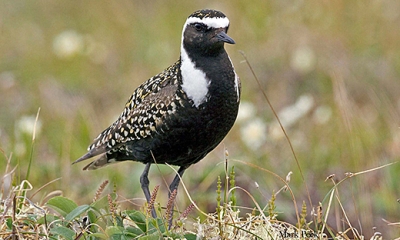
These elegant shorebirds are found as often in dry or damp upland areas as they are on mudflats or beaches. The plain brown immature birds of autumn become spangled with black and gold as breeding approaches.
It is an occasional to uncommon migrant in western Oregon (mainly coastal) and locally rare, irregular migrant in eastern Oregon, with most reports at Malheur National Wildlife Refuge, in the Klamath Basin (summer) and in Umatilla County.
Hear the call of the American golden-plover
Photo by Mark Peck, Flickr

The Long-billed curlew is the largest North American shorebird. Its most striking morphological characteristic, the long decurved bill, is an adaptation for foraging on earthworms or burrow-dwelling organisms like shrimp and crab.
Body plumage is a rich buff with a tinge of cinnamon or pink. Sexes have similar plumage, but females are larger with a longer bill. It can be distinguished from other curlews in flight by its bright cinnamon underwings. When observed on the ground, the Long-billed curlew's head lacks the strongly streaked pattern of other cerlews or Whimbrel.
It is a locally common breeder in open grassland areas east of the Cascades. It is most abundant in the Columbia River basin followed by the Harney/Malheur Lake area.
The Long-billed curlew is an Oregon Conservation Strategy Species in these ecoregions: Blue Mountains, Columbia Plateau, East Cascades, and Northern Basin and Range.
Hear the call of the Long-billed curlew
Photo by Dave Budeau, ODFW
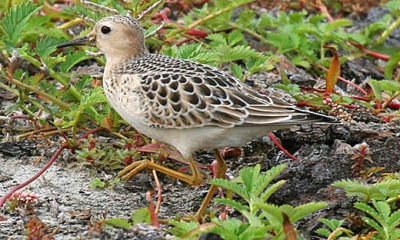
The Buff-breasted sandpiper resembles a plover with a high-stepping, pigeon-like gait. One of the few Oregon shorebirds that frequents dry, sparsely vegetated coastal grasslands.
Fall migrants consist of juveniles. It has scaly, buffy-brown underparts, yellow legs, a small head, and a short black bill. Beady black eyes stand out on a plain, pale face. It bobs its head while moving. Gleaming white underwings are displayed in a graceful flight pattern. It is unique among North American shorebirds in having a lek mating system.
This is a rare but regular fall migrant on the Oregon coast where it has been recorded in every coastal county. It has been seen in the fall on Sauvie Island and in the Rogue Valley.
Hear the call of the Buff-breasted sandpiper
Photo by ©Greg Gilson

These delicate and truly golden plovers that pass through Oregon in fall are always a delight to find on an open beach or grassy coastal plain. The Pacific golden-plover feeds mainly in the open.
A rare to uncommon migrant; most birds occur in fall on the outer coast. They are very rare to rare in winter on the coast and in the Willamette Valley.
Hear the call of the Pacific golden-plover
Photo by Dave Budeau, ODFW

A large, long-legged wader distinguished from similar species in a flight by flashing rufous underwings and dark brown primaries. Its feet extend beyond tail tip in flight.
Flocks generally consist of fewer than 50 birds on the coast. Juveniles migrate south several weeks later than most adults. After mid-November, a few stragglers are seen until late December.
The Marbled godwit is a regular spring and fall migrant on the Oregon coast. Spring migration commences in early April and extends through early June on the coast. Its average arrival at the Malheur National Wildlife Reserve is April 27.
Hear the call of the Marbled godwit
Photo by ©Keith Kohl, ODFW

The male Ruff is a relatively large, distinctive, Eurasian shorebird that in breeding plumage sports head tufts and neck plumes from which it gained its name. However, most Ruffs seen in Oregon are juveniles that appear as lanky, buff-colored, pot-bellied, short-billed sandpipers showing white on both sides of the rump in flight. Females are about 20 percent smaller than males and are referred to as reeves.
It is usually found on mudflats of coastal estuaries and adjoining wet meadows. The Ruff takes mostly aquatic insects, but will take crustaceans, mollusks, and some worms as well.
The Ruff is a rare fall transient and very rare spring transient, and is usually found on the coast, in Oregon. Some have been seen inland, near Sauvie Island.
Photo by Nick Goodrum, Flickr

This small shorebird moves along the sand by foot rather than flight.
It has a distinct black cap behind a white forehead, a dark line though the eye, and an incomplete black breast band. Males have darker and more distinct breeding plumage than females; both sexes loose coloration during late summer. It is the only shorebird that regularly breeds on Oregon's beaches.
East of the Cascades, the Western Snowy plover is a summer resident breeding on alkaline flats and salt pans. On the Oregon coast, this species is found year-round between Heceta Head and Cape Blanco.
Western snowy plovers are Oregon Conservation Strategy Species in the Coast Range, Northern Basin and Range and Nearshore ecoregions.
Hear the call of the Western snowy plover
Photo by ©Keith Kohl, ODFW

The noisy and frenetic Ruddy turnstone is a stocky, plover-like bird who's breeding plumage is a clown like pattern of black, rust and white. Ruddy turnstones have been found foraging in the company of many other shorebird species.
Found on rocky shores, jetties, open ocean beaches, mud flats, salicornia marshes, grass flats and flooded fields, the Ruddy turnstone is an opportunistic feeder.
It is an uncommon to common spring and fall transient along the coast; a few birds remain to winter there each year. The largest flocks are seen during spring and fall migration at Bandon. They are an irregular spring and occasional fall transient inland west of the Cascades.
Hear the call of the Ruddy turnstone
Photo by Dave Budeau, ODFW
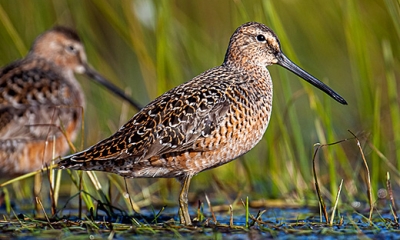
These chunky medium-small shorebirds are quite colorful in oranges and browns during most of their time in Oregon, where they are found mainly along the coast and locally in muddy areas inland. Their feeding motion has been likened to a sewing machine as flocks move slowly through shallow water and wet mud, probing with long straight bills.
They are occasionally seen in marginal areas such as flooded pastures, but less likely than Long-billed to use such upland locations.
They are a common to locally abundant coastal migrant, less common and more local in western interior valleys, and rare bur regular east of the Cascades.
Hear the call of the Short-billed dowitcher
Photo by Steve Dimock

These small, chunky plovers are uncommon to locally abundant migrants statewide, where they are among the most visible and easily identified small shorebirds. The only single-banded plover that occurs in Oregon, they can be remarkably easy to see when they are moving about on mud flats, and remarkably hard to detect when only their unmoving brown backs are visible against the mud.
It is an uncommon to locally abundant migrant, with most birds at estuaries and some concentrations in spring at larger lakes of southeast Oregon. In the fall, it's rare in the Cascades; in winter, it's uncommon at larger estuaries, especially on the south coast, is rare in western interior valleys and essentially is absent east of the Cascades.
Hear the call of the Semipalmated plover
Photo by ©Greg Gilson

Along coastal shores and islands, the chatter and flight calls of Black turnstones invite an observer to look more closely at the rocky substrates to find these birds busily picking about in their search for food.
They primarily use rocky shores, jetties, and offshore islands, but may also be found on shorebird flats and sandy beaches.
The Black turnstone is a common transient and winter visitant on the coast.
Hear the call of the Black turnstone
Phogo by ©Keith Kohl, ODFW

This medium-sized shorebird is the most common dowitcher in eastern Oregon and inland locations, where it sometimes gathers in large flocks feeding in shallow water. It is also the only dowitcher in the state that regularly winters.
Although breeding plumage adults are reddish below and heavily patterned above, most birds seen in Oregon are duller postbreeding adults or browner immatures. During winter, when shorebirds are hard to find, a small flock of chattering dowitchers, even in plain gray basic plumage, often brightens a day in western Oregon.
In migration, it can be found at almost any shallow water site in the state, from Malheur Lake to small potholes in the western interior valleys and the mudflats of the outer coast. Winter distribution is more limited with most birds on the coast.
Hear the call of the Long-billed dowitcher
Photo by Kathy Munsel, ODFW
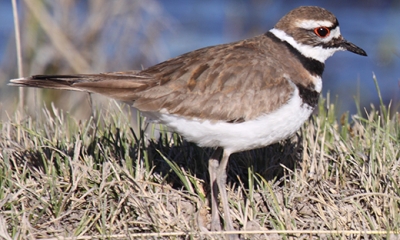
With a widespread distribution and affinity for open habitats, the Killdeer is one of the most common and recognized birds through much of North America. Killdeer are large for a plover and easily distinguished from other North American plovers by their characteristic two black or brownish-black breast bands.
Killdeer are well known for their loud and persistent call of "kill-dee, kill-dee," heard at all times of day or night on both the breeding and wintering grounds. Killdeer often nest close to human activities. Adults perform an elaborate and exaggerated broken-wing display to lure humans and potential predators away from their nests.
It is a common spring and summer resident throughout the state with breeding records from every county, although absent or rare at higher elevations. During winter, Killdeer are uncommon to rare in eastern Oregon, but common to abundant west of the Cascades.
Photo by Charlotte Ganskopp
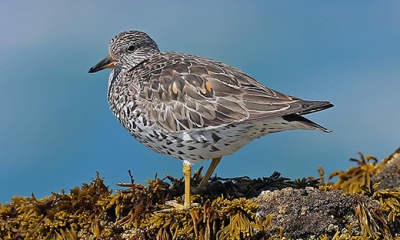
This stocky, medium-sized shorebird is a denizen of Oregon's rocky shoreline, foraging as close to the crashing waves as possible, hence its name.
It uses the rocky intertidal zone which includes jetties, offshore rocks and rocky shorelines, sea stacks, and tidal pools and is occasionally found on sandy beaches interspersed with groups of rocks, and on mudflats near the mouth of the Coquille River. It sometimes uses freshwater outfalls for bathing.
Birds wintering in Oregon have the upperparts, head, neck, and breast slate gray with a whitish eye-ring. Indistinct supercilium and chin are white, wheres the belly and abdomen are whit with dark brown streakings. Legs are short and yellow, while the plover-like bill, well adapted for plucking off young barnacles, mussels, and snails, is brown with an orange base.
It is a fairly common migrant along the coast during fall and spring with large numbers resident during the winter months.
Photo by ©Keith Kohl, ODFW

Cryptically colored, usually solitary and somewhat secretive, the Wilson snipe is often flushed before being seen, sometimes exploding from practically underfoot and rocketing off in a corkscrew flight.
This plump-bodied, long-billed bird of open marshland is primarily crepuscular, peaking in feeding activity at dusk and dawn, and often sleeping during the day. In breeding season they become more flamboyant, appearing atop fence posts and displaying their unique winnowing flights from high in the air, their outer tail feathers vibrating with an eerie whistling sound.
They are uncommon and local west of the Cascades in the summer and uncommon and local in the Cascades in the breeding season. They are a common summer resident east of the Cascades. They are uncommon to common in winter at lower elevations along the coast and in inland valleys, and can be locally abundant where birds gather to feed in coastal pastures and other wetlands.
Hear the call of the Wilson's snipe
Photo by Dave Budeau
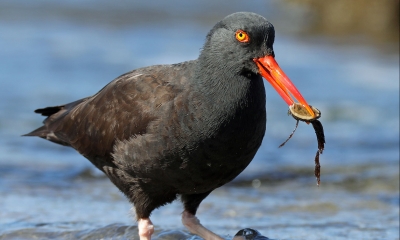
The Black oystercatcher is easily recognized with its black plumage, long, strait, laterally compressed, orange-red bill with a yellow tip, orange-red eye ring, yellow iris, and pale pink legs. These birds are restricted to rocky coastal shorelines where they feed in the intertidal zone.
They are an uncommon to fairly common resident on rocky shores and sand/gravel beaches along the entire coast. Along the sandy central coast, they are present only as an occasional dispersing or wandering individual, typically on jetties.
Black oystercatchers are Oregon Conservation Strategy Species in the Nearshore ecoregion.
Hear the call of the Black oystercatcher
Photo by Keith Kohl
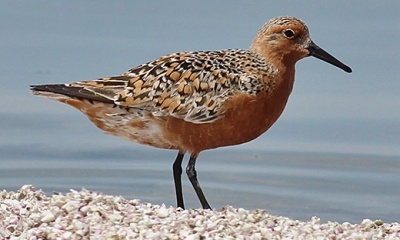
These stocky shorebirds stand out among their fellow migrants in spring, resplendent with rich rufous breasts shading into white on the lower belly. Red knots have short, black bills tapering to a fairly fine tip; short legs give them a low-slung appearance. They are highly gregarious and tend to form tight foraging and roosting flocks.
Found primarily on the coast, they are regular transients in spring and fall. Knots forage on open estuarine tide flats, less commonly on margins of sand ocean beaches. Inland, they are found on margins of sewage ponds and at large brackish lakes such as Malheur and Summer Lakes.
Photo by Tom Benson, Flickr

This is the largest and most terrestrial of the three species of phalaropes in Oregon. It is similar in shape to other Phalaropes, but larger size, longer bill and neck, lack of bar on the wing, and white rump distinguish it. In adaptation to a more terrestrial life than other Phalaropes, its toes are fringed, not lobed.
It is a common transient and breeder east of the Cascades. The largest numbers breed on the great marshes of southeast Oregon. They are rare visitor west of the Cascades.
Hear the call of the Wilson's phalarope
Photo by Charlotte Ganskopp

This fragile-looking bird with bold black-and-white plumage and exaggerated, long, reddish legs is often associated with American avocets at shallow inland ponds and lakes. Very noisy and aggressive in protection of its nest and young, using a variety of distraction displays, including an impressive broken-leg act to lure away interlopers.
The Black-necked stilt is a locally uncommon to fairly common summer resident of Klamath, Lake, Harney and Malheur counties. The largest Oregon breeding colony is at summer Lake. It has become a regular spring and fall migrant through eastern Oregon and irregular spring and casual fall migrant through western Oregon.
The Black-necked stilt is an Oregon Conservation Strategy Species in the Northern Basin and Range ecoregion.
Hear the call of the Black-necked stilt
Photo by Dave Budeau, ODFW
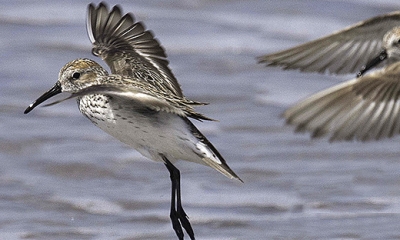
These small gray-and-white sandpipers are commonly seen on beaches from early fall through late spring running in and out along the surf's edge.
Buffier, spangled juveniles can be seen in late summer but the stunning rufous breeding plumage is less often seen and can be starling and confusing. The larger size, larger bill, and different habits of the Sanderling help distinguish it in all plumages from other small sandpipers.
It is common to locally abundant on open sand beaches from fall through spring. Statewide, it is a rare to locally uncommon migrant inland, most often reported along the Columbia River and at eastern Oregon lakes. It is also a rare migrant in northeast Oregon and Malheur County.
Hear the call of the Sanderling
Photo by Tim Moore
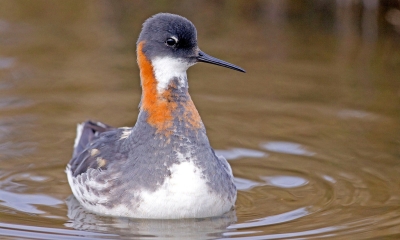
The thick, dense feathering on its underparts allows this dainty shorebird to float high on the water. Its lobbed toes give it considerable maneuverability while swimming. It is equally at home on the roughest seas and the smallest farm pond. A highly sociable bird and extremely trusting. Smaller size and slender bill separate this species from the Wilson's and Red phalaropes.
Offshore it concentrates along tide rips and over upwellings. In shallow waters it stirs the bottom with its feet or spins rapidly to expose the tiny organisms that it picks up with its needlelike bill. An opportunistic forager of small animal life, insects and copepod crustaceans are its main source of food.
In Oregon, it is a common to abundant migrant along the coast and over the ocean with 21 miles of shore. There is a secondary flyway through central Oregon that brings large numbers to Lake Albert in Lake County and to other alkaline lakes. Over most of the state small groups of up to 10-12 birds are regularly seen. Small numbers occasionally remain to summer east of the Cascades.
Hear the call of the Red-necked phalarope
Photo by Mark Peck, Flickr

A conspicuous wader of shallow wetland habitats with a striking appearance and graceful movements. These long-legged shorebirds have contrasting black and white upperparts and during the breeding season, the head and neck turn from gray or white to a deep rust color. One of their most notable traits is a long, slender upturned bill.
It is a common breeder east of the Cascades at wetlands of south central and southeast Oregon. Distribution and number of breeding birds vary annually depending on regional and local water levels and habitat availability. Regardless, most breeders occur in the western Great Basin counties of Klamath, Lake, Harney, and Malheur.
Hear the call of the American avocet
Photo by Dave Budeau, ODFW

This tiny sandpiper is the rarest of the regularly occurring "peeps" in Oregon. Only a handful of individuals are reported in Oregon each year, mostly during fall migration and usually in mixed flocks with Least and Western Sandpipers.
Like the Western sandpiper, the Semipalmated has black legs, but its bill is generally shorter, straighter and more blunt. Well-known as a transoceanic migrant, the Semipalmated sandpiper may be one of the fastest flying of the long-distance shorebirds.
It is a rare irregular spring transient throughout Oregon, and a very uncommon coastal and rare inland fall transient. It is usually found inside coastal bays along intertidal sand or mud flats, and occasionally on exposed ocean beaches; also found at the borders of grassy marsh and tidal flats.
Hear the call of the Semipalmated sandpiper
Photo by Andrew Cannizzaro, Flickr
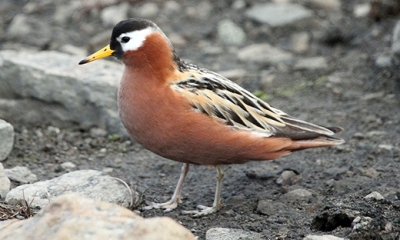
Flying over the water in small flocks or riding the ocean swells like puffs of down, a more incongruous picture can hardly be imagined than these dainty mites riding the waves during rough weather, apparently entirely indifferent to the tumult of waters.
Pelagic shorebirds, they come to shore only to breed. Adapted to life on the sea, they have glands that allow them to expel salt from the seawater they drink, and lobed, coot-like toes to swim. Brick red in their breeding plumage, they are mostly gray and white in winter.
They are uncommon to common spring and fall transients, primarily offshore, small numbers are regular onshore. They are irregularly rare to common in winter.
Hear the call of the Red phalarope
Photo by Michael Horn, Flickr

This unusual shorebird breeds along rivers, streams, and lakes in a variety of habitat types throughout the state, from sea level to near timberline.
Conspicuous by its distinctive teetering behavior, boldly spotted underparts, and noisy alarm calls, it is usually the only breeding shorebird present in its preferred habitat.
The appearance of a sandpiper along a tiny tributary in the upper reaches of a heavily forested watershed can be startling to one unfamiliar with the species' ubiquitous nature.
The Spotted sandpiper is a widespread transient and breeder throughout the state, found in nearly every county in Oregon. Most birds depart the state by October.
Hear the call of the Spotted sandpiper
Photo by ©Greg Gilson

At certain estuaries and interior alkali lakes, flocks of many thousands of these migrants can be observed swirling around over shallow water, landing to frantically feed, before resuming migration.
Falcons often attack Westerns, and their acrobatic, tightly coordinated escape flights are breathtaking to observe.
In winter, these small sandpipers are gray above with white underparts. In breeding plumage they have a rich rufous-chestnut back, cheeks and cap, dark-centered scapulars with rufous-chestnut edges, grayish throats streaked with dark chevrons through the flank, and whitish underparts. Longer-billed females generally are larger than males but are otherwise similar in appearance.
Along the coast of Oregon, the Western sandpiper is the most abundant shorebird in estuaries and along beaches during migration. Generally, larger flocks are seen in fall than in spring. The largest concentrations of migrant birds are usually found at Tillamook Bay, Bandon Marsh and the Columbia River estuary. During winter along the coast, Westerns are occasional to uncommon.
Hear the call of the Western sandpiper
Photo by ©Keith Kohl, ODFW

The enigmatic Solitary sandpiper may be one of the least understood of Oregon's regularly occurring shorebirds.
As its name implies, the species is most often found singly, and it rarely occurs in groups of more than two individuals. The Solitary sandpiper frequents habitats not often utilized by other migrant shorebirds, such as smaller and often partly wooded patches of water, and high-altitude bogs and wet meadows.
It is an uncommon to rare migrant in fresh water or brackish habitats throughout Oregon; rarest along outer coast and in alkali habitats. Spring adults more common in the western interior valleys; fall juveniles are more common than adults in all regions an more common east of the Cascades.
Hear the call of the Solitary sandpiper
Photo by David Bronson, ODFW

This is the world's smallest "peep" and can usually be picked out by its brownish coloration, dull yellowish legs, and hunched, creeping foraging style. Least can be found in small flocks in Oregon almost year-round.
The Least sandpiper feeds on open mud with Western sandpipers but often feeds where some grass, salicornia or other cover is present, avoiding walking in the water as Western often do.
It is uncommon to locally abundant statewide in migration, with most birds along the coast and at larger lakes and marshes inland. It is locally common on the coast in winter; smaller numbers winter in the western interior valleys, where small flocks can be found at larger lakes, locally in flooded fields and sometimes even at marginal sites such as sewage ponds. A few birds winter east of the Cascades where appropriate habitat remains open.
Hear the call of the Least sandpiper
Photo by ©Keith Kohl, ODFW

The presence of this medium-sized shorebird often is announced by its high-pitched ringing call as it forages along rocky coastlines amid crashing waves.
Unlike most shorebirds, Wandering tattler is a loner and is rarely encountered in flocks. Loose aggregations may sometimes be found together strung out along jetties in migration.
The Wandering tattler is a fairly common migrant during spring and fall along the entire Oregon Coast.
Hear the call of the Wandering tattler
Photo by Dave Budeau, ODFW
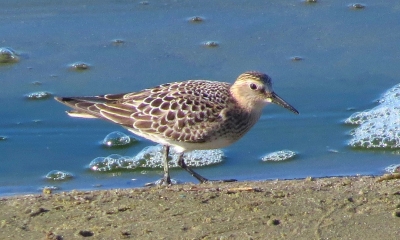
These large "peeps" are seen in Oregon mainly in late summer and fall, when their size, scalloped buffy plumage, and long profile help them stand out in flocks of other small sandpipers.
It is an uncommon migrant statewide, with most birds southbound juveniles. It can occur in suitable habitat anywhere in Oregon, but numbers are usually very low and sizable flocks almost nonexistent.
Hear the call of the Baird's sandpiper
Photo by Howard Patterson, Flickr

